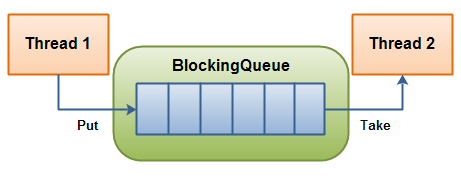java.util.concurrent.BlockingQueue 接口代表了线程安全的队列。
BlockingQueue的使用
一个BlockingQueue的典型使用是一个线程不断生产对象往队列里放,另一个线程往队列里取对象进行消费。

生产线程会保持一致产生新的对象并且插入到队列中,直到队列到达了它的存储上限,生产线程再往队列插入时会发现阻塞,并且一直保持阻塞直到消费线程从队列中取出一个对象。
消费线程会保持从队列中取出对象并且进行处理,如果消费线程试图从一个空的队列中取出对象,那么消费线程将会阻塞直到生产线程往队列中放入了新的对象。
BlockingQueue的方法
BlockingQueue由4中不同的方法来添加,删除和检测。每组方法有不同的特点泳衣满足不能立即执行响应请求的操作。
| 操作 | 抛出异常 | 返回操作结果 | 阻塞 | 超时 |
| 插入 | add(o) | offer(o) | put(o) | offer(o,timeout,timeunit) |
| 删除 | remove(o) | poll(o) | take(o) | poll(timeout,timeunit) |
| 检测element(o) | peek(o) |
1.抛出异常:如果对应方法没有立即执行则抛出异常。
2.返回操作结果:如果对应方法立即执行返回true,否则则返回false(超出队列容量)。
3.阻塞:如果对应方法无法立即执行,则将阻塞等待直到方法完成。
4.超时:如果对应方法无法立即执行,则会一直等待但不超过给定的超时范围,返回相应的结果。
BlockingQueue的实现类
ArrayBlockingQueue
DelayQueue
LinkedBlockingDeque
PriorityBlockingQueue
SynchronousQueue
BlockingQueue的示例
// 文章开头生产与消费的示例
public class BlockingQueueExample {
public static void main(String[] args) throws Exception {
BlockingQueue queue = new ArrayBlockingQueue(1024);
Producer producer = new Producer(queue);
Consumer consumer = new Consumer(queue);
new Thread(producer).start();
new Thread(consumer).start();
Thread.sleep(4000);
}
}
// 生产者
public class Producer implements Runnable{
protected BlockingQueue queue = null;
public Producer(BlockingQueue queue) {
this.queue = queue;
}
public void run() {
try {
queue.put("1");
Thread.sleep(1000);
queue.put("2");
Thread.sleep(1000);
queue.put("3");
} catch (InterruptedException e) {
e.printStackTrace();
}
}
}
// 消费者
public class Consumer implements Runnable{
protected BlockingQueue queue = null;
public Consumer(BlockingQueue queue) {
this.queue = queue;
}
public void run() {
try {
System.out.println(queue.take());
System.out.println(queue.take());
System.out.println(queue.take());
} catch (InterruptedException e) {
e.printStackTrace();
}
}
}



 本文深入探讨了Java.util.concurrent.BlockingQueue接口的使用方式,包括其核心概念、方法及其常见实现类如ArrayBlockingQueue、DelayQueue等。通过生产者-消费者模式示例,详细展示了如何利用BlockingQueue接口实现线程间同步和异步数据交换。
本文深入探讨了Java.util.concurrent.BlockingQueue接口的使用方式,包括其核心概念、方法及其常见实现类如ArrayBlockingQueue、DelayQueue等。通过生产者-消费者模式示例,详细展示了如何利用BlockingQueue接口实现线程间同步和异步数据交换。

















 1598
1598

 被折叠的 条评论
为什么被折叠?
被折叠的 条评论
为什么被折叠?








